
Chinese civilization has a long history and has given birth to many excellent traditional cultures over thousands of years, which still have practical and aesthetic values even now. In different geographical spaces, their cultural forms are differentiated and their traditional elements are diverse, which is the only way to make art works more layered. Therefore, this paper takes “the integration of Chinese traditional elements in visual communication design” as an important research perspective, and studies the integration of traditional elements with Chinese characteristics, so as to make the visual performance more national, further inherit and carry forward the excellent traditional culture of China, and realize the inheritance and innovation of culture.
Visual communication design has become a form of artistic expression that can be seen everywhere in people’s life nowadays, and it is also an important element that affects human visual experience and cultural thought [1,2]. No matter how much history has changed, the cultural heritage has never been interrupted, and with the fusion of multi-ethnic cultures, a unique traditional cultural system has been formed. With the increasing cultural confidence of the Chinese people, artists and designers, and design works with traditional Chinese elements have become more and more popular, and even some international luxury brands have used a lot of traditional Chinese elements in their product designs to open up the Chinese consumer market [3]. However, due to the limited education, inexperience or laziness of design workers in the design process, some design works repeatedly misuse traditional Chinese cultural elements, confuse the symbolic meaning of traditional patterns and offend national taboos. Only by reasonably applying Chinese traditional elements to visual communication design can we design excellent works, more accurately convey visual information, promote traditional culture and national spirit, and, at the same time, create more market value [4].
Chinese traditional elements are rich in content, such as the art of paper-cutting, ink painting and calligraphy [4,5]. In the wash of history, Chinese traditional culture has formed unique connotation characteristics with the passage of time and changes, and has gathered the crystallization of human wisdom and the accumulation of local cultural connotation. Traditional Chinese cultural elements have not disappeared with the passage of time, but still preserve their own unique artistic value in the process of development [6]. Until now, these very excellent traditional cultural elements contain many special spiritual connotations and elements of the times, so that the traditional cultural elements are given a more new meaning and social development more adaptable, more effective inheritance of excellent cultural content. In addition, the combination of traditional Chinese cultural elements in art design can highlight the extremely mysterious color of oriental culture, and the use of special forms for the dissemination of these cultures can enhance the effective communication between Chinese cultural elements and some other foreign cultures, and influence people’s lives in a subtle way, which has an important role in cultural inheritance and promotion [7,8].
Most of the outstanding works of visual communication design are combined with real life and repeatedly constructed with people’s personal experience. These include the design of corporate brand images, the design of electronic advertising content, the design of product packaging, the design of corporate logos, etc. As an important expression of modern business, visual communication design is an important bridge for communication and exchange between enterprises and consumers. In the design process, patterns, words and colors are integrated, and special expressions are used to present the important effect of promoting and developing products [9,10].
The promotion and application of Chinese elements in the design field can largely enhance national self-confidence. For example, the “China Seal” of the Beijing 2008 Olympic Games brings a strong cultural connotation to the viewers with typical Chinese elements. In addition, the color expression of the emblem of the Beijing 2008 Olympic Games also integrates traditional Chinese color elements, plastic art and visual communication design, expressing the unique Chinese colors and integrating the characteristics of Beijing with the elements of the Olympic movement [11,12]. The “Chinese Seal – Dancing Beijing” uses the seal as the main content of the whole creation, incorporating the traditional Chinese culture of calligraphy and seal expression, and then subtly deforming it to show the effect of forward movement and dancing, as if it were a forward moving figure. Among them, the shape of the “human” fully reflects the charm of the modern character “Jing”, and such a pattern has a very strong Chinese flavor in its later expression [13,14].
Nowadays, the development of society gradually enters the “picture reading era”, no matter it is advertising design, book binding or packaging design, all will highlight their own unique characteristics in the graphic performance. It is an important embodiment of modern art creators to capture the visual experience and psychological needs of human beings, and it is also the most important content in the communication and expression of visual forms. However, there are still some problems in the actual application, and designers need to pay more attention in order to integrate traditional elements into the design of works in a more reasonable way, so as to achieve the desired effect.
The core of Chinese traditional elements is the Chinese civilization. Among the four major cultural systems in the world, Chinese culture stands out in terms of continuity and extension. Whether it is fancy costumes, gardens, Chinese qin, chess, calligraphy and painting, poems and songs, gold, stone, silk and bamboo, pear orchestra, tea and fragrance, martial arts, traditional Chinese medicine, folklore and folk crafts, all of them are rooted in the soil of Chinese civilization and are inextricably linked with people’s life and production [15]. Through thousands of years of evolution, traditional Chinese aesthetics has become unique in the world culture.
Since the Frenchman Rainer Grousset mentioned “Oriental aesthetics” in “From Greece to China” in 1948, there has been a “conscious awareness” of the East’s own aesthetic tradition, and the real factors of contemporary daily life, such as clothing, food, housing, transportation, and use, are “enveloped in aesthetics” [16,17]. The aesthetic view of traditional Chinese culture has entered a state of “awakening”.
At the same time, many excellent world-class design masters have emerged in the combination of traditional culture and modern design, such as Kazumitsu Tanaka, Kazumasa Nagai, Kenya Hara, etc. (Figure 1 shows the series of posters “Japanese Dance” created by Mr. Ikko Tanaka using modern design language and Japanese folklore.)
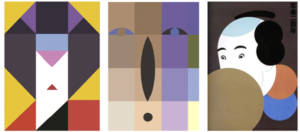
The development of a nation needs deep cultural roots and a strong inner spiritual force to support it. Design competitions and academic discussions on the combination of traditional culture and modern design are being held continuously. However, Chinese design still needs to be significant in the international arena, and there are bound to be problems emerging in this process of development and transformation, just like what Mr. Chen Danqing said, we have a lot of radical and pompous in the rescue and application of culture, and maybe this is our way of doing things “tradition”, especially in the current fast-paced society, coupled with the domestic environment and the influence of the system, many people can not dive into the quiet to do learning, radical utilitarian drive leads to the study of culture can not go deep, the majority of superficial forms. Of course, there are a few outstanding predecessors who are worthy of our consideration and study, such as the famous Hong Kong designers Chen Youjian and KAN Tai-keung, who have made great progress in the study of tradition and modernity, and whose design works are permeated with the deep charm of traditional culture, and have set an example for us in the study of the combination of traditional and modern cultural expression. (Figure 2 Image of Chen Youjian Design Company, Figure 3 Phoenix TV logo, Figure 4 China Unicom logo, Figure 5 Application of traditional auspicious pattern of clouds in Beijing 2008 Olympic Games).




To be successful, visual communication design must be deeply rooted in the vast cultural soil of the place where the product is marketed, in addition to being closely linked to its own brand culture. When combining foreign brands with Chinese traditional elements, we should focus on whether the visual effect of the brand’s brand tone and the combination of Chinese traditional elements is in line with Chinese style and culture. For example, Hermes brand and Chinese urban culture elements, Audi car and Chinese ink and landscape elements, Starbucks and Chinese traditional festivals, Coca-Cola and Chinese colors, a wine industry and Chinese traditional stories and many other brands combined with Chinese traditional elements of visual effects are in line with the unique culture of China [18].
In 2017, Ding Yi was invited to design a set of silk scarves for the world-renowned Hermès, called “Autumn/Winter 2010 Collection – Chinese Rhythm”, and held Hermès “The silk scarf show was held in Shanghai and Beijing. The motifs on this set of silk scarves are arranged by colorful blocks of colors, skyscrapers lined up, and flashing and jumping light patterns, with a striking rhythm of colors, just like the never-ending life living in the city (Figure 6). Ding Yi has said that when he conceived the idea, he positioned China in his mind in the concept of “contemporary”, and that he wanted to show the world a contemporary China, not the traditional impression of China. Through this exhibition, the Hermes brand has succeeded in gaining more attention and love from Chinese consumers.
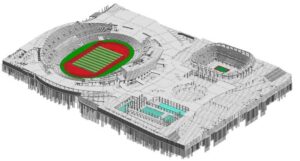
Another example is the Audi campaign “Passion in Writing” (Figure 7). Audi depicts an ink painting of a mountain range on the body of the off-road vehicle. When you first look at the body of the Audi, it looks like the mud that is thrown on the body of the car when driving at a fast speed. However, after a closer look, you will find that this is a combination of real and imaginary ink and landscape painting, viewing its painting is like driving this car through the mountains and forests, giving people a feeling of being in the real world and being at ease. This kind of traditional Chinese ink and wash expression is simple and rich in meaning, expressing a rich message with very few elements, and has now become a unique form of painting in China.
The idea of Audi Q7 not only shows the ingenuity of Chinese landscape painting, but also changes people’s perception of the rough and bold style of off-road vehicles. Based on the product positioning of off-road vehicles, Audi found Chinese elements suitable for its own brand and established brand roots in line with Chinese culture, becoming the first premium car brand in China with sales exceeding one million.

For example, Starbucks is a famous coffee shop chain in the U.S. In January 1999, Starbucks entered the Chinese market, and the designers launched mooncakes in the Chinese market in order to integrate with traditional Chinese culture, so that the Starbucks brand could establish a closer relationship with traditional Chinese festivals. This was followed by the continued launch of the Zodiac savings jar, which incorporates Chinese elements. The Chinese flavor is reflected in this design chapter. Both the color and the pattern blend with Starbucks to make Chinese customers truly feel the ubiquity of Chinese culture.
In addition, some international brands also like to use Chinese theater, blue and white porcelain, traditional patterns and other elements and symbols, the integration of the brand and traditional Chinese cultural characteristics to make the brand tone closer to the Chinese humanistic feelings. For example, PUMA’s “See you in Beijing” series, which incorporates Chinese Peking Opera faces into the PUMA Jaguar series, is a clever innovation of traditional Chinese elements and modernity, and conveys to consumers the PUMA brand’s design concept of “sports and fashion lifestyle” (Figure 8). The Puma Jaguar collection incorporates traditional Chinese elements and modern innovations to convey the Puma brand’s “sports and lifestyle” design philosophy (Figure 8).

In order to reflect the unique Chinese red color, Coca-Cola added the image of the cartoon character “Ah Fook” with the festive Chinese red in its packaging design back in 2001, which can be said to be an authentic Chinese design.
A wine industry is known worldwide for launching stylish and original limited editions. For example, the Disco Series in 2007, the Masquerade Series in 2008, the Absolut Mini Bar Limited Edition in summer 2009 and the Absolut Rock Limited Edition in winter 2009 were all very well received by consumers. “The launch of this limited edition has made it possible for a wine company to create a new wave of “Chinese style” by combining classic Chinese elements with Western design concepts. The launch of this limited edition has given the brand of a wine industry a strong contemporary Chinese flavor. At the same time, Chen Man, a leading Chinese fashion photographer, created a series of graphic design works for “72 Changes” (Figure 9).

The design concept of “square” in Chinese traditional culture is in full swing in the shape and packaging of the Oriental Leaf Tea series, with the real bottle presenting a classical flavor design feeling[24]. In the design of the brand logo, the designer used a combination of traditional hand-drawn illustrations and computer technology to present an excellent bottle label design with both classical beauty and modernity (Figure 10).

Finally, the main design theme of Laofengxiang jewelry is to show a quiet and peaceful and exquisite brand image, a national brand with Chinese flavor, which conveys the good wishes of prosperity, good fortune and success, focusing on the understanding and expression of Chinese national culture. Therefore, its logo adopts a combination of traditional Chinese patterns and traditional Chinese characters. The phoenix symbolizes nobility and majesty in the traditional Chinese understanding. Therefore, the Lao Fengxiang jewelry also has the same noble, elegant and auspicious meaning (Figure 11).

At the present stage, with the collision of Chinese and Western cultures, some college students are influenced by the infiltration of Western culture and question the traditional Chinese culture, they cannot understand and cognize the importance of traditional culture at a deep level, but lack the autonomy to follow the European and American culture and Japanese and Korean culture, etc. This is expressed in the psychological cognition and also reflected in many aspects of daily behavior and habits, especially at the present stage some college students are blindly pursuing foreign brands and have the situation of following and comparing. In particular, some college students are blindly pursuing foreign brands and following the trend of comparison. To elaborate on the root cause of this problem, it is mainly due to the lack of objective cognition of students, as well as their failure to deeply appreciate the profoundness of the excellent Chinese traditional culture, coupled with the lack of clear directional guidance, which makes them produce an unobjective, incorrect and unscientific cognition. Based on this development situation, the development of the visual design field needs to play its own fashion guidance value, starting from the design process to cultivate students’ rational thinking, so that they can grasp the Western cultural concepts and at the same time have an objective cognition of the excellent Chinese traditional culture, and explore the cultural heritage contained in the Chinese traditional elements from a deeper level, which includes good visual aesthetics and profound cultural atmosphere, etc.
At this stage of rapid social development, people’s material needs have been greatly satisfied, the consumer’s consumption concept should be guided by scientific direction, to avoid unnecessary directional bias. Nowadays, consumers pay more attention to the connotation of the product, its cultural characteristics, and whether both innovative thinking and so on in the process of consumption. Based on the change of consumer habits, designers need to do a good job of grasping the future direction, based on the aesthetic needs of consumers, to determine their psychological potential, and then use a very local design style to attract the eyes of consumers, through a very characteristic product design, to strengthen the emotional communication between designers and consumers. For example, at present, people’s cognition of Chinese traditional culture still stays on a few traditional elements, and it is necessary to realize the organic application and design of Chinese traditional elements according to the control requirements of the design style and highlight the cultural information of the design scheme. In the process of integrating Chinese traditional elements, avoid colliding them with Western culture, but really highlight the uniqueness of Chinese art from a deep level, so as to enhance the inner cognition of the masses and awaken their memory of the excellent Chinese traditional culture with excellent design works, so that they can form a strong emotional experience and then deeply experience the connotation and essence of the excellent Chinese traditional culture.
Chinese traditional patterns “must be intentional and auspicious”. In the visual communication design, traditional patterns are the most frequently and effectively used elements. Traditional auspicious motifs are usually derived from the working people’s reverence and love for people, flowers, birds, animals, the sun, moon, stars and other natural features, and are used to create motifs with allegorical symbols and textual harmonies, and are used for various decorative beautification in daily life. For example, dragon and phoenix culture is a unique and mysterious source culture in Chinese civilization. The dragon is the longest of all insects and the phoenix is the king of all birds, both of which are symbols of the Chinese nation. The dragon originated from the totem worship of the ancestors, and later people called themselves the heirs of the dragon, and ancient emperors also borrowed the dragon to mythologize themselves. The image of dragon is often used to represent Chinese culture in design works. The visual elements of dragons and phoenixes are rich in imagination, and because of their many forms, they can be figurative or abstract, which in no way affects the Chinese people’s love for dragon and phoenix motifs. In visual communication design, dragon and phoenix elements represent noble and auspicious, yin and yang harmony.
The auspicious cloud pattern, which originated from the bronze decoration of the Shang and Zhou periods, is one of the most auspicious patterns with Chinese characteristics. They are widely used in architecture, embroidery, porcelain and other decorations by ancient people, and their varied and fluid expressions are also liked by art creators. In the visual communication design, auspicious clouds are more often used as the border and base pattern, which is a “versatile” element.
In addition, the passion of Chinese working people for life is reflected in auspicious motifs such as flowers, birds and animals. The primitive ancestors were aware of the relationship between nature and human beings, and drew their understanding of human beings, fish and the source of life on pottery; in the Bronze Age, they cast and engraved their understanding of human beings, gods and beasts on bronze vessels; when life became stable, they used flowers, birds, fish and insects as the main themes, and extracted ornaments with auspicious meanings to be applied in life, such as the peony pattern, which symbolizes wealth and prosperity, the bat pattern, which is in harmony with “Fu The effective implementation and use of auspicious elements makes people full of hope and have their own expectations when they actually live and work. “The Chinese use these techniques to the extreme, and their more subtle three-dimensional presentation is actually more artistic than Western techniques.”
Symbiosis graphics can be divided into symbiosis of nature, symbiosis between man and nature, symbiosis between man and society, symbiosis between man and God, symbiosis between cultures and so on from the reflected thematic content, and mainly adopt the formal beauty laws such as sharing, symmetry, balance, rhythm and rhyme in the structural form. (Figure 12-Figure 15 represent the concept of symbiosis between man and nature, between nature, between man and society, and between cultures, respectively.)




Traditional Chinese painting uses brush, ink, paper and ink stone as special tools to break the limits of time and space, the unique perspective theory of painting is constructed, and the imaginative moods created by the use of brush and ink between the square and the inch are complemented by the unique literati spirit and the art of calligraphy and seal engraving, making Chinese painting a colorful addition to the history of world painting, see Figure 16.
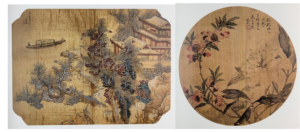
The art of Chinese painting and calligraphy is a very representative cultural symbol of traditional Chinese culture. In modern visual communication design, the four treasures of calligraphy and painting are often used to represent the heaviness of Chinese culture and create the beauty of mood with ink and wash elements. The fusion of the art of white space in painting and modern minimalist design style produces a new Chinese style, which is widely used in interior design and poster design.
In ancient China, the word “danqing” was used to refer to painting, i.e. red, tansa, cinnabar and similar colors, and green, which is composed of stone green, stone green and other colors. Green landscape was born from Buddhist frescoes, and is one of the more influential types of Chinese painting. The popular “national trend” in visual communication design, with traditional elements and rich lime green colors, has the beauty of traditional and modern aesthetic collision, and is loved by the public.
As the name implies, ink painting thus showing a unique sense of layers in the painting, which is called “ink rhythm”. In the early days of ink painting, the main focus was on landscape painting. The expression of black and white tones made landscape painting unique and charming, and with the use of various painting techniques, ink painting was perfectly presented. Chinese ink painting has a long history, beginning in the Tang Dynasty and flourishing in the Song Dynasty, and has continued to develop in the process of inheritance, making the presentation of ink painting more and more refined. The rational use of this unique form of artistic expression in visual communication design has promoted a breakthrough in design, which not only allows people to feel the charm of traditional culture, but also allows the combination of ink painting elements and the times to burst forth with new effects. The creation of ink painting emphasizes “vividness” and “writing God with form”, which mainly expresses the “rhythm” and “realm” of scenery. “To achieve the ideal design effect, we must fully understand the characteristics of ink painting and the way of painting, and adopt contemporary design concepts and design techniques to reflect the simple and subtle beauty of ink painting. The use of ink painting elements can play a role in rendering the whole work, making the content of the work vivid and delicate, and can give the visual communication design work to be creative, making the overall artistic aesthetic enhance a level.
Paper-cutting is a popular art form because of its easy availability of materials, low cost and simple and interesting creation process, see Figure 17. Paper-cutting activities are often carried out during folk festivals, and the subjects are all auspicious and prayerful, reflecting the optimistic and positive attitude of the working people.

For example, among the paper-cutting elements used in folk marriages during the Jiaqing period, the magpie signifies a happy event, the mandarin ducks are a metaphor for a like-minded couple, the dragon and the phoenix signify harmony between men and women, and the fish has a powerful reproductive function, signifying many children, and harmonizes with the word “Yu”, signifying a yearly surplus. In addition, the twelve Chinese zodiac signs are also common themes in paper cutting, which can be used as a series of distinguishing elements in visual communication design.
The art of paper-cutting is expressed in the form of scissors and knife carving, and the pattern presents a sense of simplicity, so it is more commonly used in visual communication design for some agricultural brand logos, illustrations and packaging. It should be noted here: the wedding words, the Mandarin ducks playing in the water, etc., can only be used on specific occasions to avoid ambiguity.
The Dunhuang Mogao Caves are known as a museum of Oriental art. In addition to depicting Buddhist statues, sutra paintings, and portraits of supporters, the Dunhuang murals also make extensive use of decorative motifs. Decorative motifs from various periods of time and in different popular styles are painted on figures and costumes, on top of the treasures, or embellished in the main body, between scenes, or drawn in an overall arrangement in algal wells, all showing the high painting skills and unique aesthetic sensibilities of the ancients, see Figure 18.
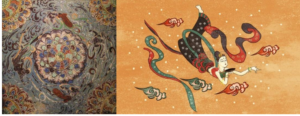
The decorative style of algal well patterns in the Tang Dynasty was inherited and showed some innovation. A very strong sense of hierarchy dominates, forming bifurcated continuous geometric patterns, vine patterns, etc. As civilization progressed, and with the influence of foreign cultures, the Dunhuang algal well pattern became typical in design among Chinese decorative designs. To a large extent, Dunhuang frescoes provide a comprehensive view of the spiritual connotations of the Chinese nation.
With the development of contemporary cultural tourism, cultural and creative products and brand packaging are concerned with the integration of Dunhuang art elements, injecting the factor of artistic masterpieces to enhance their own brand effect and cultural connotation. For example, major brands have launched Dunhuang Museum co-branded goods to open up the market for national brands.
In the development of Chinese history, costumes have also undergone a new iteration of development, and after each dynasty was established, some improvements were made to the costumes, and the costumes of different dynasties were very different, and the content contained in the costumes was very rich, which not only reflected the cultural characteristics but also reflected the aesthetic interests of people at that time and the cultural characteristics of China’s costumes, see Figure 19. Through the ethnic costumes, we can also see the development of Chinese culture, the regional situation, etc., and also reflect the ideology and class division of the rulers at that time. The penetration of traditional costume can reproduce the traditional aesthetic concept, and the work can reflect significant characteristics, and the profound connotation contained in it can make people have a deeper recognition of the product concept.
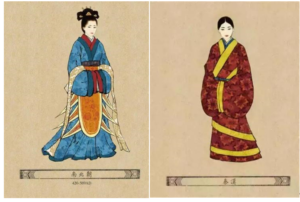
The most unique traditional Chinese element is the traditional Chinese painting, also known as “national painting”. It is one of the traditional Chinese plastic arts. Traditional Chinese painting has its own distinctive characteristics. In his “Ancient Paintings”, painting theorist Xie He used the “six methods” as the standard for measuring the success or failure of painting: vividness, use of bones and brushwork, responding to objects and picturing them, assigning colors to them, managing their position, and transferring them. Therefore, Chinese painting is about “writing God with form” and pursuing the feeling that “the beauty lies between likeness and unlikeness”, which is very much in line with a wine industry’s brand tone of individuality, openness, uniqueness and creativity.
Among the famous artists of the heyday of Chinese painting, Zhu Da, a famous calligrapher and painter of the Qing Dynasty, started a new generation with his unique look of simple brushwork painting of flowers and birds. His painting style is extremely concise; he does not paint the concentration of birds foraging for food, but only the delightfulness of a solitary bird. In the vague picture of the ink lotus, there is no hustle and bustle, no seeking for desires, only peace and loneliness (Figure 20). However, although his painting style is very unique, the mood of flower and bird painting is far less strong than that of landscape, and the mood of the original painting is much missing after processing, which is not effective.

This ink-based landscape painting is significantly different from the “ink and pale” style of the “green and delicate” painting, and the scroll is a masterpiece of green landscape painting. The work depicts a river with vast waves and rolling hills forming the landscape of Jiangnan (Figure 21).The scenes in the painting are a perfect combination of movement and stillness. The characters and animals in this work are extremely detailed, with vivid expressions and moods, making it a work of great skill. Since “Thousand Miles of Rivers and Mountains” is presented in the form of a long scroll, the length of the bottle sticker was limited, so it was decided to intercept some of the images and make several attempts to adjust them after computer graphics processing, and select the work that best reflects the mood of “Thousand Miles of Rivers and Mountains” The design of the Chinese landscape painting series is intended to show the majestic appearance of China’s thousands of miles of rivers and mountains through the bottle of a world-renowned wine brand (Figure 22).
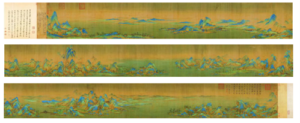

For the design of the Absolute Rivers and Mountains bottle sticker, a series of extended items were developed to achieve a better series and to promote the appearance of Chinese rivers and mountains through the Thousand Miles Rivers and Mountains (Figure 23 to Figure 27).

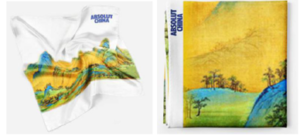
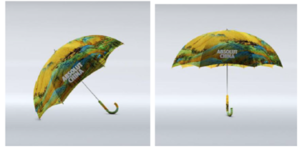
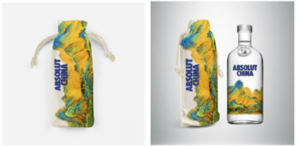

Since the pattern of auspicious clouds in the 2008 Beijing Olympic Games appeared in the world’s view, traditional Chinese patterns have been known to the world. Different traditional patterns can reflect the spirit of different periods and regions. Moreover, traditional patterns provide creative inspiration and numerous artistic expressions for contemporary art design due to their unique style.
Traditional Chinese patterns are expressed in realistic, realistic and deformed ways. Contemporary artworks have incorporated the traditional pattern elements into the works in a new situation, producing a new kind of artistic content. For example, the curved water pattern is smooth like water, which can be gentle and soothing or passionate (Figure 28).Another example is the cloud pattern, which symbolizes things going well and rising high, and has been integrated into different eras for use and innovation through a long historical development (Figure 29). This pattern is an imaginative decorative style created by exaggerating the morphological characteristics of flowers and plants. It is not a pattern of flowering branches and leaves, but a pattern of coiling and twisting, with the aura of auspicious clouds and the mood of Buddhist objects. Therefore, it is a new and unique pattern in Chinese Buddhist decoration (Figure 30).


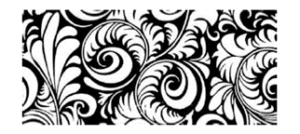
The development and utilization of traditional patterns is an important element for modern design. Traditional motifs are a carrier of Chinese culture and are an integral part of modern design. In the design of traditional Chinese motifs, a new perspective and level of observation and analysis of traditional Chinese motifs are combined with the brand tone of a wine industry, and the deeper excavation, refinement and application of traditional Chinese motifs expand a broader design space, prompting us to better inherit and promote traditional Chinese motifs.
A series of designs of traditional Chinese motifs from a wine industry was chosen for the curvy water, curly grass and cloud motifs. The design is innovative with the carp from the ocean, the Tibetan antelope from the land and the crane from the sky. In addition, the pure and unique brand tone of a wine industry was integrated into it, creating a sense of mood that is integrated with a wine industry. Therefore, the design of the bottle sticker incorporates the blessing of “absolute good luck”. Finally, the crane and cloud motifs were conceived from the beauty of the Chinese landscape of the crane. The combination of the crane and the clouds is appropriate because of the similarity in meaning between the crane and the clouds (Figure 31).
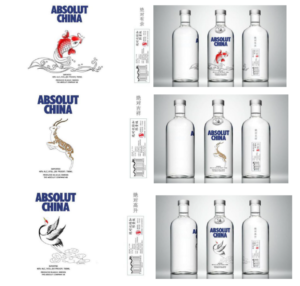
In order to better promote the brand, we designed and applied derivatives for the Absolute Surplus, Absolute Auspicious and Absolute High Rise launched by a wine industry (Figure 32 to Figure 35).




In summary, the article mainly analyzes the application of Chinese traditional elements in visual communication design. Combining Chinese traditional elements with visual communication design can build a special cultural connotation, make visual communication design show a more diversified development trend, and further enhance people’s spiritual pursuit on the basis of satisfying human material needs. The application suggestions of Chinese traditional elements in visual communication design are given, and the following aspects should be taken into account in the application process to ensure the effect of the design work.
This study received funding support from the following sources:Key research project of the 2023 Shanxi Fine Arts Education Society’s scientific research special project(Research on the Path and Method of Building Practice Bases for College Fine Arts Education) No.SXSMYZX2023007.